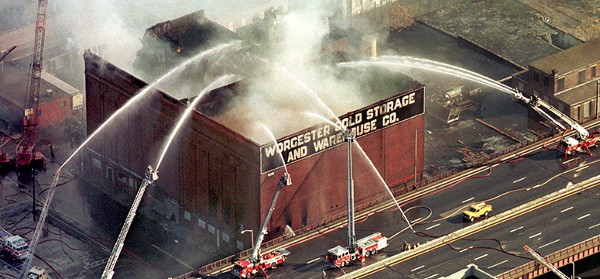What made the Worcester Cold Storage Fire unique offers lessons about fighting fires in large, abandoned structures
Many of the deadliest fires in U.S. history occurred before U.S. fire safety recommendations were recorded or codified—but the tragic Worcester fire happened despite modern measures.
In 1871, the Great Chicago fire burned over three square miles of the city, killing 300 before burning itself out. At the time, the National Fire Protection Association (NFPA) did not exist.
By the time the Iroquois Theater fire killed more than 600 patrons in 1903, NFPA was a fledgling organization just seven years old. It was no coincidence that one of the earliest committees it formed (in 1904) was “Theater Construction and Protection.”
Eight years after the NFPA began writing fire safety code—including conducting investigations after major incidents—the Triangle Shirtwaist Factory fire forced workers to jump from windows and killed about 147 people (mostly women and girls) after factory owners had ignored fire safety recommendations.
Horrific events like these early 20th century fires are less frequent today, due largely to the lessons of tragedies that transformed into improved fire safety code. Better NFPA code has informed changes in how buildings are designed and building materials are selected, as well as recommending the use of effective fire suppression systems like automatic sprinklers.
Fires that burn unabated and kill multiple firefighters or civilians are unlikely in modern times. But the 1999 Worcester Cold Storage fire harkened back to earlier times—it happened in a building almost a hundred years old.
The abandoned Worcester Cold Storage and Warehouse Co. building, built in 1905, was the stuff of firefighters’ nightmares: maze-like passageways, rows of identical rooms with identical flush-mounted handles, highly flammable insulating materials, and a vast interior with few vertical escape routes.
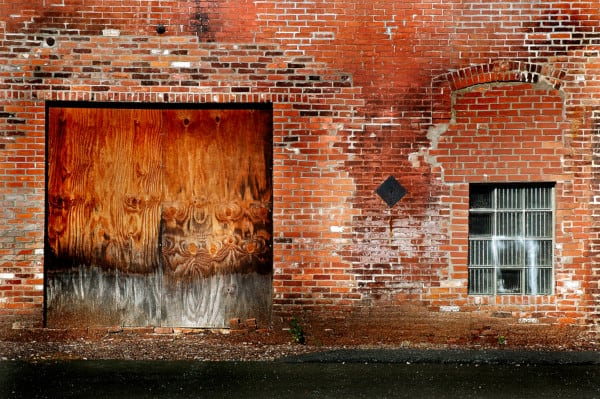
After the fire, reports circulated that, for years, Worcester fireman had been by turns concerned and terrified about ever having to fight a fire inside.
And the Worcester fire tragically validated these worries.
Is fire prevention, firefighting, or training firefighters part of your job? Consider our selection of tools that help firefighters perform their jobs safely, including the Night Saver glow-in-the-dark rope. The Night Saver is a breadcrumb trail out of the darkness, aids in all low-light conditions, and can be used as a versatile guide rope. Looking for life safety rope? We also offer the highly rated Bulwark X in various sizes for both safety training and field use.
Worcester witnessed the birth and rise of U.S. manufacturing
The Worcester Cold Storage and Warehouse Co. building was a huge brick edifice built at the turn of the 20th century. It stood on the edge of downtown Worcester, MA, where it gobbled up an entire city block. But the facility, once bustling with workers storing and shipping meat by rail, sat empty and silent at the turn of the 21st century, except for a handful of illegal tenants: members of the town’s homeless population.
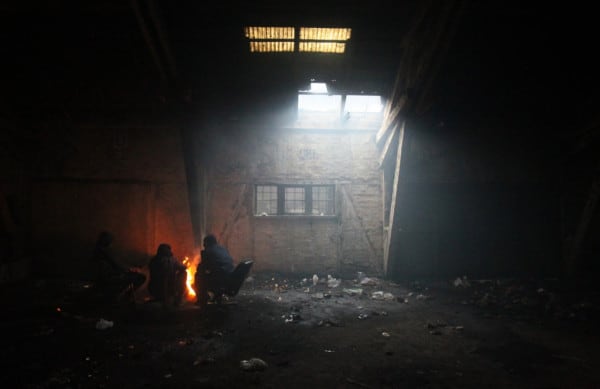
Worcester is an old town, settled by Europeans in the early 1700s. It flourished as a manufacturing hub when the Boston & Worcester Railroad put down tracks in 1835. Today, the city has a population of more than 185,000 and is part of the larger Boston metropolis, the sixth-largest metropolitan area in the world.
The cold storage facility got a substantial addition in 1912. While its original scope reached 88 x 88 feet, climbing 80 feet high in six stories, the expansion added significant square footage. Ultimately, its 64,000 square feet of enclosed space formed an L with a single—albeit unplanned and informal—firewall between its vertical and horizontal legs, according to a U.S. Fire Administration report after the fire.
The 1912 expansion created twice as much square footage but only added a few windows to a second-floor office, two elevators, and an additional staircase the terminated on the third floor. The total staircases numbered three, but only one climbed from the basement to the roof.
Aside from the two warehouse floors, the vast interior held rows and rows of indistinguishable cold storage units: sometimes one unit opened into three more, which were also identical. Reports indicated that when the facility was in operation, it was not unusual for workers to get lost due to the inherently confusing network of meat lockers. The building’s primary purpose was to store beef from Chicago slaughterhouses, then haul the meat out the back door for distribution via railroad cars.
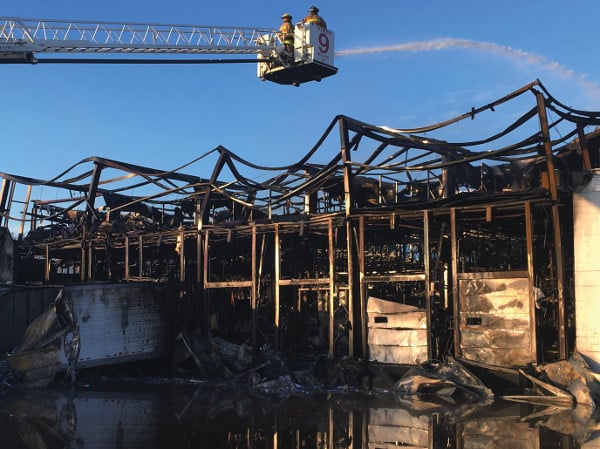
The facility was designed to optimize insulation, so only the first floor included windows, except in stairwells. The massive brick exterior walls were 18” thick—but that was only the beginning.
Another 18” layer of cork insulation was combined with even more insulating materials, such as polystyrene foam, tar, and polyurethane. As materials improved over the decades, more insulation was periodically added. The end product was a nightmare of combustibles, according to a National Institute for Occupational Safety and Health (NIOSH) investigation after the fire.
After the building was abandoned in 1989, its thick walls and small, cozy rooms offered shelter, privacy, and warmth. Squatters sometimes built fires or brought candles with them to find their way. In April 1999, the Worcester Fire Prevention Unit filed an official complaint and ordered the building’s owners to secure the facility, asserting that gaining illegal access to the interior was too easy, the NIOSH report states.
The combination of layout, darkness, only one usable staircase, and an endless series of identical meat lockers—in addition to the structure’s sheer scope—created a bewildering blueprint where navigation in the best of circumstances proved challenging.
It was here, one cold night in December two decades ago, where six firefighters intending to search for anyone inside never found their way out.
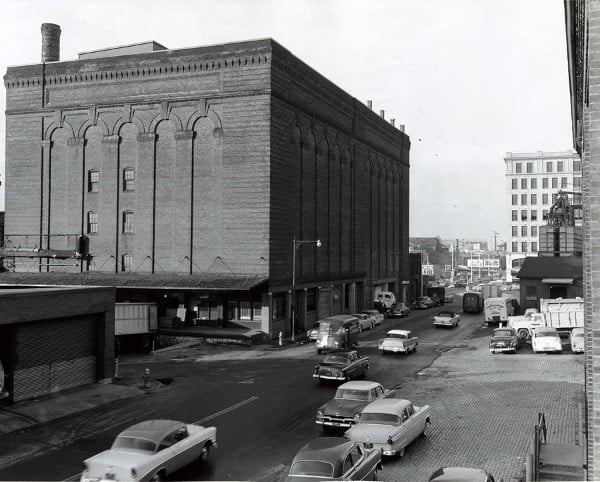
Firefighters were trapped in a maze during the Worcester fire
According to a report by FEMA (Federal Emergency Management Agency), three factors are frequently implicated in large-loss building fires: detection time, building construction, and building contents. All of these played supporting roles in the Cold Storage and Warehouse fire. But the loss of life can be squarely pinned on the factors that made escaping the structure close to impossible.
The cold storage building was estimated to have been burning between 30 and 90 minutes before it was detected. That’s largely due to the time it took for the smoke to become visible outside the building.
The fire likely started around 5 p.m. on Dec. 3 when Thomas Levesque and Julie Ann Barnes, two homeless squatters, were camped inside the cold storage facility and toppled a candle during an argument. Unable to quell the flames, they fled the building, electing not to tell anyone.
A business owner next door informed the firefighters there could be people in the vacant building, but even without that warning, it is likely firefighters would have felt compelled to conduct a search based on common knowledge about how the building was used.
The first alarm sounded at 6:13 p.m. Four engines carrying two ladders and a rescue company arrived with a district fire chief to the raging three-alarm fire. Those arriving on the scene were divided into two crews to search the building. Official review after the fire and extensive reports from such sources as NIOSH and NFPA revealed the following timeline:
- At 6:20 p.m., Ladder 1 reported it was on the second floor putting in several 2.5” hose lines. Some of the firefighters instantly voiced concerns about the fire’s behavior: doors that had been opened around the building, combined with the rooftop vent at the top of the elevator shaft, were pulling the fire toward the elevators and sucking smoke and heat higher into the structure. Fueled by the lethal layers of insulation, the cold storage building was essentially becoming a giant stove.
- The four hoses working the fire barely dented it. Conditions inside much of the building deteriorated rapidly, with dense, acrid black smoke descending through the floors and stairwells.
- At 6:46 p.m. and 6:47 p.m., two radio reports come from inside from Rescue 1: two of the firefighters sent to search the interior of the building had an emergency.
- At 6:53 p.m., Rescue 1 was directed by Car 3 to activate their PASS (Personal Alert Safety System) devices, used by firefighters to send distress signals.
- Additional firefighters were sent inside the building to find victims 1 and 2 from Rescue 1, who had been identified following a headcount by the onsite interior command (IC).
- At 7:10 p.m., one of two firefighters (victims 3 and 4) sent in to search for victims 1 and 2 radioed an urgent message to command stating they were lost and running low on oxygen.
- At 7:14 p.m., victims 3 and 4 radioed the same message again. The message from this team stated, “Ladder 2 to command, we’re done….” This transmission was the last from the search team of four men sent into the burning building from Ladder 2/Engine 3.
- At 7:24 p.m., IC conducted another headcount and discovered a grim surprise: six firefighters were missing.
- At 7:31 p.m., a second fire department from Millbury, MA, arrived with a thermal imaging camera to help locate the lost men.
- At 7:49 p.m., a crew from Engine 8 [unrelated to the victims] reported that the structural integrity of the building seemed compromised on the fourth floor.
- At 7:53 p.m., a report from Car 4 stated that the thermal imager had stopped working, later determined to be due to the intense heat of the fire.
- At 8 p.m., IC ordered all firefighters out of the building and switched from offensive to defensive firefighting. Search-and-rescue operations were halted until the fire was out.
Later, it was determined that victims 5 and 6, who were not seen entering the cold storage building, had not radioed any type of message. Transcripts from Central Dispatch imply these two men may have joined victims 3 and 4 on the fifth floor. Recovery efforts lasted for eight days.
The six men who perished are remembered by the city and greater firefighting community as “The Worcester Six.” While Worcester reeled from the deaths, the fire department (with support from multiple agencies beyond the city of Worcester and the state of Massachusetts) took a hard look at the tragedy to prevent any such event in the future.
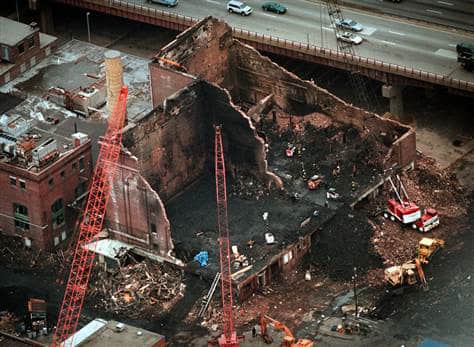
The Worcester fire’s aftermath brought tears, lawsuits, and action
The city of Worcester vowed to never forget this fire and it has kept that promise. Memorials are held each year, some with ceremonies at 6:13 p.m., the time the first alarm rang on that December evening 20 years ago. The ruins of the Worcester cold storage facility were cleared and a new fire station, The Franklin Street Station, was built on the ashes.
The building’s owner was sued by the families of the six men who died, ultimately resulting in small, out-of-court settlements of between $167,000 and $250,000 each. The homeless couple was charged with involuntary manslaughter, but after the case was dismissed and reinstated it was finally dismissed in 2010. Both eventually received probation.
The closely-knit community of Worcester created a scholarship fund that has raised over half a million dollars to support local high school students in memory of the lost firefighters, while fundraisers and non-profit foundations were also established.
Firefighters in Worcester turned their grief into concrete action by investigating why the men were lost and assessing how events could have unfolded differently.
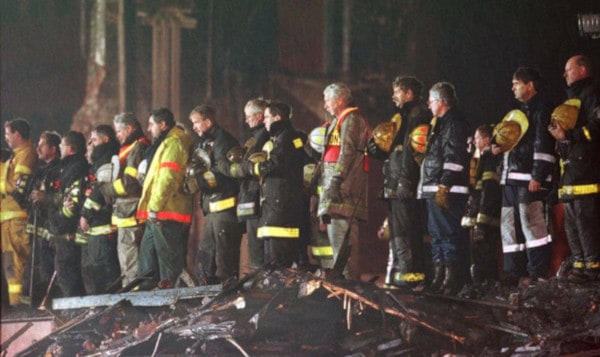
The Worcester fire: lessons learned about vacant buildings and modern combustibles
Despite hundreds of volumes of NFPA code dedicated to optimal safety procedures, vacant buildings can be filled with flammable materials and typically lack working fire extinguishers. Older buildings may also be without fire suppression systems such as fire sprinklers, and even when they exist, owners may have turned off the water source needed to make sprinklers operate.
Abandoned buildings are often boarded up, limiting both lighting and exit options. Responders who arrive on the scene also encounter inherent navigational risks because they lack knowledge about what’s inside.
The cold storage building brought together the worst possible architectural design (from a fire safety perspective) and highly flammable materials in one building.
At the 20th anniversary of the Worcester fire, an NFPA Journal report explained that the Worcester Cold Storage and Warehouse Co. building created the perfect conditions for an out-of-control inferno:
“Polystyrene, polyurethane, and Styrofoam—like the asphalt infusion, all petroleum products—were later layered over the cork, creating a sandwich of insulating materials that, given the right conditions, could pack the combustibility of gasoline. There were few windows in the building, and most had been boarded over. Most of the floors were mazes of storage lockers; wayfinding was nonexistent….”
More information about the building layout and hazards could have better prepared the incident commander to make informed decisions about fighting the fire. Noting the dangers of both arson fires and fires in abandoned buildings, the Massachusetts Fire Marshal has taken many measures since the Worcester tragedy to improve safety for firefighters, such as more frequent patrols to discourage vagrants and enforceable fines for non-compliant building owners. Additionally, fire code in the state now includes marking vacant buildings.
After the Worcester fire, the NIOSH report urged fire departments to prepare for possible fires in high-hazard vacant occupancies by creating detailed pre-fire plans. It also recommended multiple-company, onsite training sessions supervised by a battalion chief to practice large-scale firefighting operations at these locations.
According to NIOSH, the pre-fire strategy should consider:
- Potential hazards inside
- Water supply
- Defensive strategy
- Exposure protection strategy
- Mutual aid considerations
- Collapse dangers
- Apparatus positioning
- Venting strategies
The U.S. Fire Administration also issued a report which summarized the key issues involved in the Worcester fire:
- Abandoned building left unprotected and unsecured
- No barriers to prevent the spread of fire and smoke in a large space
- Fire spread via combustible interior finishes
- Delayed fire reporting
- Access limitations for fire suppression and rescue
- Unusually long interior travel distances
These findings largely highlight the unique nature of the Worcester Cold Storage and Warehouse building itself, rather than lapses in the fire department or firefighting strategy. NIOSH does note that improved navigation could have mitigated the outcome of the cold storage fire.
Firefighter search rope doubles as communication and a way out
Safety gear such as oxygen and protective suits are of limited value when firefighters become lost and/or separated from one another. The NIOSH report includes 13 recommendations for improving firefighter safety in vacant buildings culled from the lessons of the Worcester tragedy. These include having Rapid Intervention Teams (RIT) specially trained in locating and rescuing downed firefighters ready to deploy as soon as engines arrive on scene, and ensuring equipment can handle the amount of radio traffic that occurs at multiple-alarm fires.
The need for search rope was also emphasized in the NIOSH report:
“Recommendation #6. Use guide ropes/tag lines securely attached to permanent objects at entry portals and place high-intensity floodlights at entry portals to assist lost or disoriented firefighters in emergency escape.”
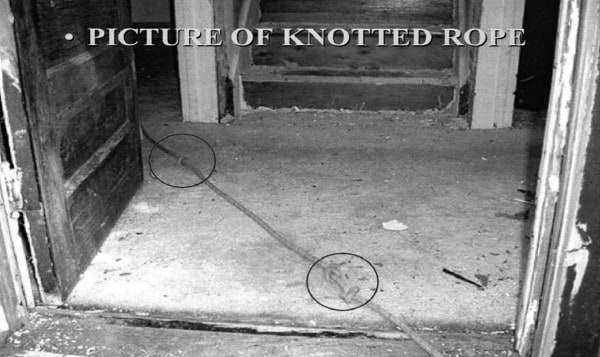
NIOSH recommendation #9 after the Worcester fire notes that a marking system should also be established when searching a building. When combined with the use of search rope, such a system could have provided a much-needed orientation point, or points, in a building like the cold storage facility that lacked navigational waypoints. By knotting ropes in a particular pattern, a firefighter can feel his or her way out of the building; for instance, two knots tied together can indicate the direction to the exit.
While it is difficult to conceive of a setting less maneuverable than the cold storage building, NIOSH reviewers also recommended posting information outside of all vacant buildings about interior conditions:
“Recommendation #1. Ensure that inspections of vacant buildings and pre-fire planning are conducted that cover all potential hazards, structural building materials (type and age), and renovations that may be encountered during a fire so that the incident commander will have the necessary structural information to make informed decisions and implement an appropriate plan of attack.
Recommendation #10. Identify dangerous vacant buildings by affixing warning placards to entrance doorways or other openings where firefighters may enter.”
With proper training and practice, using a search rope can mean the difference between staying connected to another firefighter or having the ability to find a building exit in darkness and/or heavy smoke. The high visibility of a glow-in-the-dark search rope provides even greater confidence and orientation that could help hasten a search team’s progress into a structure.
Firefighter disorientation—a loss of direction due to lack of visibility in a structure fire—is a hazard that often contributes to fatalities. Depleted air supply, falling debris, building collapse, and sudden flashover or backdraft pose serious threats to disoriented firefighters.
In the Worcester fire, the six lost firefighters succumbed to thermal injuries, smoke inhalation, and exposure to heat and noxious gases before they could find their way out, according to the NIOSH report.
The heavy use of synthetic materials in buildings, furniture, and appliances is changing structural fires, creating thick, black smoke that quickly leads to zero visibility. Deploying a glow-in-the-dark search rope is like posting neon exit signs for a firefighter.

The 3/8-inch diameter Night Saver in the 600-foot or 1,200-foot length is used by firefighters to help them retreat from untenable interior positions. It’s small enough to be flexible when it’s tied or looped onto objects to mark a path, and not too cumbersome to pack alongside all the other gear firefighters lug. That diameter is also big enough to be easily located and held with a gloved hand. It can also easily be knotted to indicate distance or direction as firefighters move throughout a large, difficult-to-navigate structure.
Of course, search rope is only one tool and not a cure-all for an incident as complex as the Worcester fire. But post-incident reports state that although many tools were issued to the firefighters—including Self-Contained Breathing Apparatus (SCBA) with 30 minutes of air and PASS units for sending distress signals—a consistent problem in the cold storage fire was incident commanders not knowing where to send rescue teams, and losing track of men who entered the building. This problem was due, in part, to the scale and size of the structure.
With proper training, search rope can serve as an effective means of communication in dim conditions, especially when high-tech means of navigation fail. In the cold storage fire, for example, thermal imaging was brought on the scene but failed to operate correctly. A properly deployed glow-in-the-dark search rope could have led Rapid Intervention Teams to injured firefighters and helped prevent them from becoming lost in the first place.
Lessons learned from the “perfect fire”
An Esquire article following the Worcester Six tragedy was titled “The Perfect Fire,” echoing another Massachusetts tragedy chronicled in the 1997 bestseller, The Perfect Storm. In that incident, multiple factors converged to create a storm so vast and treacherous that no boat captain or crew could have anticipated or adapted to it. And, in an eerie coincidence, six fishermen were lost aboard the Andrea Gail.
Worcester’s so-called “perfect fire” highlighted a pressing need to develop effective new technology for fire departments and the 13 NIOSH recommendations have largely been deployed in Massachusetts. For example, fire departments have adopted a marking and placard system for abandoned buildings.
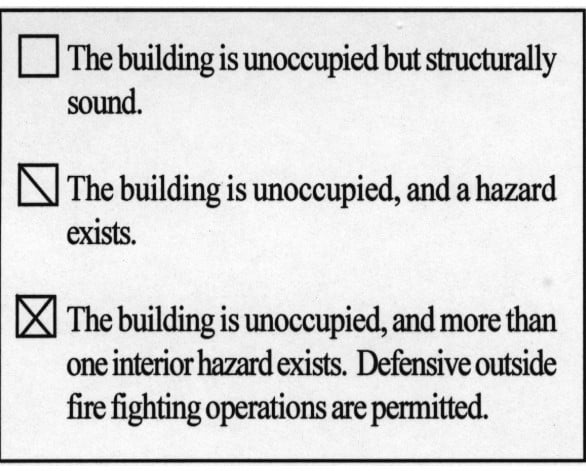
Difficulty locating firefighters among multiple teams spread out in a large structure also prompted a concentrated effort to strengthen Rapid Intervention Teams. After the Worcester fire, RIT in Massachusetts were increased from two to four members, sent into buildings with additional tools such as search rope and air packs, and tasked with “softening” the building as soon as they arrive to minimize “mayday” potential. For instance, an RIT might remove doors, burglar bars, or locks that could impede hasty exits from a structure.
Perhaps these improvements, more than any memorial, pay tribute to the Worcester Six who died trying to rescue others.
Ultimately, fighting fires in abandoned buildings will always be challenging. But many of the issues that led to the firefighters’ tragic deaths in Worcester do have solutions. Knowing the true conditions within the building would still have forced a tough call: enter a risky structure or choose to fight defensively, knowing that people may have been inside.
But marking vacant buildings, practicing potential firefighting scenarios at high-hazard facilities, using special teams like RIT, and arming firefighters with tools like glow-in-the-dark rope that can keep them from becoming disoriented can vastly improve the odds of survivability.
QRFS carried a selection of tools that help firefighters perform their jobs safely, including the Night Saver glow-in-the-dark search rope and the highly-rated Bulwark X technical-use life safety rope. If you have questions or need something that you cannot find on the website, call +1 (888) 361-6662 or email support@qrfs.com.
This blog was originally posted at blog.qrfs.com. Check us out at Facebook.com/QuickResponseFireSupply or on Twitter @QuickResponseFS.


